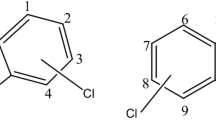The transport and fate of pollutants is often governed by both their tendency to sorb as well as their susceptibility to biodegradation. We have evaluated these parameters for 2,4,6-trinitrotoluene (TNT) and several biodegradation products. Slurries of aquifer sediment and groundwater depleted TNT at rates of 27, 7.7 and 5.9 μM day−1 under methanogenic, sulfate-reducing and nitrate-reducing conditions, respectively. Abiotic losses of TNT were determined in autoclaved controls. Abiotic TNT loss and subsequent transformation of the products was also observed. These transformations were especially important during the first step in the reduction of TNT. Subsequent abiotic reactions could account for all of the transformations observed in bottles which were initially nitrate-reducing. Other controls removed TNT reduction products at much slower rates than slurries containing live organisms. 2-Amino-4,6-dinitrotoluene was produced in all slurries but disappeared in methanogenic and in sulfate-reducing slurries within several weeks. This compound was converted to 2,4-diamino-6-nitrotoluene in all slurries with subsequent removal of the latter from methanogenic and sulfate-reducing slurries, while it persisted in autoclaved controls and in the nitrate-reducing slurries. Aquifer slurries incubated with either 2,4- or 2,6-diaminotoluene showed losses of these compounds relative to autoclaved controls under nitrate-reducing conditions but not under sulfate-reducing or methanogenic conditions. These latter compounds are important as reduced intermediates in the biodegradation of dinitrotoluenes and as industrial chemicals. In experiments to examine sorption, exposure to landfill sediment resulted in losses of approximately 15% of diaminotoluene isomers and 25% of aminodinitrotoluene isomers from initial solution concentrations within 24 h. Isotherms confirmed that the diaminotoluenes were least strongly sorbed and the amino-dinitrotoluenes most strongly sorbed to this sediment, while TNT sorption capacity was intermediate. In our studies, 2,4,6-triaminotoluene sorption capacity was indeterminate due to its chemical instability. Coupled with biodegradation information, isotherms help describe the likelihood of contaminant removal, persistence, and movement at impacted sites.
Similar content being viewed by others
Author information
Authors and Affiliations
Additional information
Received 11 March 1996/ Accepted in revised form 24 July 1996
Rights and permissions
About this article
Cite this article
Krumholz, L., Li, J., Clarkson, W. et al. Transformations of TNT and related aminotoluenes in groundwater aquifer slurries under different electron-accepting conditions. J Ind Microbiol Biotech 18, 161–169 (1997). https://doi.org/10.1038/sj.jim.2900317
Issue Date:
DOI: https://doi.org/10.1038/sj.jim.2900317




